SMART Social-Emotional Counseling IEP Goals and Treatment Plan Objectives
- Whole Child Counseling
- Jun 26, 2021
- 7 min read
Updated: Aug 22, 2025

Let’s discuss S.M.A.R.T. social-emotional and counseling IEP goals and treatment plan objectives. These goals can be hard to write since they aren’t always easy to quantify and measure. My goal is to share with you some social-emotional objectives to help you spend less time on documentation and more time doing whatever it is you want! Depending on the child’s developmental level and insight, you’ll want to co-create your goals and objectives collaboratively with the child you are working with. It is a great experience to ask children what they want to work on and then work on the goals together!

SMART Counseling IEP and Treatment Plan Goals Versus Objectives
A goal is the longer-term result that you want to achieve by the end of the treatment plan or IEP period. In the case of an IEP it's usually a one year reporting period, but a clinical treatment plan can be a shorter time period, such as 30-90 days or less. Whereas objectives are the smaller, more measurable steps that will help you achieve that goal. I think of goals as areas for broader and longer-term change and objectives are the smaller and more actionable steps that will be obtained to help you meet that bigger goal.


Since social skills, emotions, and behaviors are hard to measure, people most often struggle with writing social and emotional IEP goals, treatment goals, and objectives that are S.M.A.R.T. or
Specific
Measurable
Achievable
Relevant
Time-Limited
For a time-saving bank of SMART IEP and treatment objectives, check out my eBook: Social-Emotional IEP & Treatment Plan Objectives.

SMART Counseling Goals are Specific
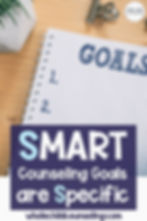
A SMART goal or objective is SPECIFIC. Be sure to use clear language rather than writing something broad like, “improve social skills”. It sometimes helps to break the behavior down into parts as well. For example, if you want to see fewer tantrums, pinpoint and describe the specific components that make up that child’s tantrum behavior.
Being more specific with your IEP or treatment goals makes it easier to determine what you will be measuring for the objectives as well. The given conditions and levels of support (such as with visuals, with verbal prompts, independently, etc.) are also areas that can lend more specificity to your goals and objectives. You can also be specific by describing a certain setting you want the behavior to occur in.
SMART Counseling IEP Objective Example:
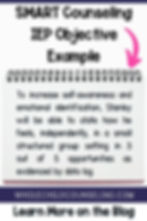
Here's an example of a SMART counseling IEP objective. You can see that this goal describes the purpose of the goal, what Stanley is expected to do, the level of support, and the specific setting.
To increase self-awareness and emotional identification, Stanley will be able to state how he feels, independently, in a small structured group setting in 3 out of 5 opportunities as evidenced by data log.
Given Condition and Level of Support When Writing IEP Goals

It is important to include the given conditions or level of support within your objectives to make them more specific. Sometimes the child would not be able to meet the objective unless these conditions were in place, so including them makes it more realistic as well (see below).
In addition, this level of specificity ensures consistency across settings. If multiple given conditions are needed, you can absolutely include more than one (e.g., “given a visual timer and gestural prompts). Consider the prompt hierarchy when writing these specific objectives as well. If the child is learning a new skill, you will likely provide a high level of support during skill acquisition. You will then fade your prompting as the child gains mastery. (Pezeshkan, n.d.)
For examples and a bank of given conditions and levels of support, check out my eBook: Social-Emotional IEP & Treatment Plan Objectives.
SMART Counseling Goals are Measurable

A SMART goal or objective is also MEASURABLE. It can be difficult to do this when you are working on social and emotional issues! Think about who will be responsible for measuring the data and how it will be collected. For most of my objectives, I use data logs with measurement points that I can observe and gather right in the session because I like to gather the data myself. I do not want to rely on other people to remember to gather the data for me and I want to ensure it is carried out with fidelity.
To make an objective measurable, you might include specifiers such as in 3 out of 4 opportunities or 9 out of 10 scenarios. You could also add specifiers such as a certain amount of time per day or per week, or for a certain amount of minutes.
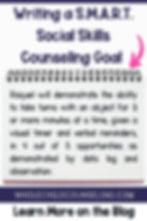
SMART Counseling Goal About Social Skills
You can also make the objective measurable by adding a certain task that needs to be performed by a certain date.
Raquel will demonstrate the ability to take turns with an object for 3 or more minutes at a time, given a visual timer and verbal reminders, in 4 out of 5 opportunities, as demonstrated by data log and observation.

SMART Counseling Goal About Coping Skills:
To increase knowledge and use of coping skills, by February 5, 2024, Warren will be able to independently identify at least 4 coping skills to assist with alleviating feelings of depression, in 4 out of 5 scenarios as demonstrated by data log and counselor observation.
There is no guesswork involved here as far as how the data will be measured and who will be doing the measuring.
I will write more about progress monitoring and data collection in a future blog, but this is also a topic I discuss in my book, Skills for Big Feelings: A Guide for Teaching Kids Relaxation, Regulation, and Coping Techniques, which comes with over 20 measurable S.M.A.R.T. objectives!
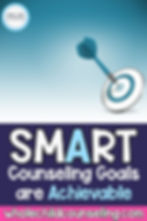
SMART Counseling Goals are Achievable
A SMART goal or objective is ACHIEVABLE. You always want to set your student or clients up for success. If your student is engaging in aggressive behavior 20 times a day, even though it is desired, it is not realistic to write that they will “eliminate 100% of aggressive behavior.” In a situation like this, you might think about reducing (rather than eliminating) either the frequency, duration, or intensity of the particular behavior.
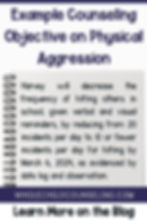
Example Counseling IEP Objective on Physical Aggression
This is a realistic and achievable goal for the student as they begin to receive interventions targeting this objective and social-emotional support.
Harvey will decrease the frequency of hitting others in school, given verbal and visual reminders, by reducing from 20 incidents per day to 10 or fewer incidents per day for hitting by March 6, 2024, as evidenced by data log and observation.

SMART Counseling Goals are Relevant
A SMART goal or objective is RELEVANT to the child’s unique needs and their goal area(s). You don’t want to have a goal about social skills with an unrelated objective targeting reading fluency. I always write my goals after the IEP meetings so I can gather lots of information from both the teachers and the families and other service providers or collateral contacts. It is also helpful to have teachers and families fill out social-emotional skills inventories, assessments, and questionnaires to help identify which areas are relevant and should be targeted.

SMART Counseling Goals are Time-Limited:
A SMART goal or objective is TIME-LIMITED. You can make your objectives time-limited by adding a date that you want the objective to occur by, such as by the end of the IEP period or by a particular date.

Writing SMART Mental Health IEP Goals and SMART Treatment Goals
When writing IEP and treatment goals, I find it helpful to start with the end in mind and work backward. Consider what you want the child to (realistically) achieve in a one-year period. Once you have the overarching goal written, you can then write the objectives for each area. I usually write 3-4 objectives per goal area, but this can vary based on the child’s needs.

SMART Counseling Anxiety Goal Example
Tina will reduce the frequency, intensity, and duration of panic attacks and other symptoms of anxiety, as evidenced by self-report, symptom log, counselor observation, and attainment of objectives listed below.
Objective 1:
By June 1, 2024, Tina will be able to identify 2 or more triggers that may precipitate feelings of anxiety or panic attacks, with fading adult support, as demonstrated by counselor observation and notes.
Objective 2:
By August 1, 2024, Tina will be able to identify 3 or more physical body sensations that correlate with feelings of anxiety or panic attacks, given fading adult support, as demonstrated by data log.
Objective 3:
Given direct teaching of relaxation skills, by November 1, 2024, Tina will be able to independently identify 3 relaxation skills to utilize when she is feeling anxious, as demonstrated by counselor observation and notes.
Objective 4:
Tina will begin practicing relaxation skills 4 out of 7 days per week, given verbal reminders, as demonstrated by practice log and counselor, parent, and teacher observation.
Use Multiple SMART Behavioral Health Treatment Objectives
In the example above, you can see how each objective moves the child closer to meeting the SMART treatment goal. First, she will learn to identify her triggers. Then she will learn to identify her physical body cues so she can develop self-awareness to know when she is feeling anxious. Next, she will learn relaxation skills to cope with anxiety. Lastly, she will practice the skills daily.
Each objective alone is specific, measurable, achievable, relevant, and time-limited. They build upon one another over time to help meet the long-term goal. Depending on the child’s progress, on the next plan I would probably start working on having her generalize the use of relaxation skills when confronted with anxiety in her daily life.
For over 450 examples of SMART IEP and treatment objectives, as well as the formula for writing objectives, check out my eBook: Social-Emotional IEP & Treatment Plan Objectives.
There are also examples of SMART IEP and treatment plan goals and aligned to my social-emotional learning curriculum included in the book: Skills for Big Feelings!

References
Pezeshkan, H. (n.d.) Prompt hierarchies. Northern Therapy Group. http://www.ntg-inc.com/uploads/3/4/5/4/34545535/prompthierarchies_ntg_2017.pdf





